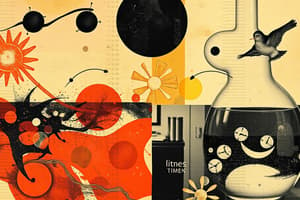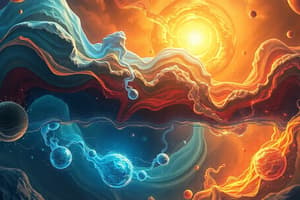Podcast
Questions and Answers
When heat is added to a solid, what is the correct order of phases it will most likely transition through?
When heat is added to a solid, what is the correct order of phases it will most likely transition through?
- Solid, then Gas, then Liquid
- Liquid, then Gas, then Solid
- Gas, then Liquid, then Solid
- Solid, then Liquid, then Gas (correct)
Condensation is the phase transition of a liquid turning to a gas.
Condensation is the phase transition of a liquid turning to a gas.
False (B)
Explain, based on particle behavior, why thermal expansion occurs when heat is added to a solid.
Explain, based on particle behavior, why thermal expansion occurs when heat is added to a solid.
Adding heat increases particle movement, causing them to push away from each other and increasing the overall volume of the solid.
The phase transition directly from solid to gas is called ______.
The phase transition directly from solid to gas is called ______.
Match the state transition to the correct addition or removal of heat (please note that a state transition can only be listed once):
Match the state transition to the correct addition or removal of heat (please note that a state transition can only be listed once):
Flashcards
Melting
Melting
The change of a solid to a liquid due to increased particle movement from added heat.
Evaporation
Evaporation
The process of a liquid changing to a gas.
Condensation
Condensation
The change of a gas to a liquid.
Taking Away Heat
Taking Away Heat
Signup and view all the flashcards
Changing State
Changing State
Signup and view all the flashcards
Study Notes
Adding Heat
- Heat causes particles to move faster.
- Particles start to make contact with each other, melting occurs (chain reaction).
- Attraction weakens as particles move and push away from others.
- Particles slip/move around each other.
Taking Away Heat
- Removal of heat causes particles to slow down (next step).
- Lack of movement allows attraction to increase.
- Deposition and sublimation occur.
- Thermal energy is removed.
Physical Changes
- There is not a new substance.
- Fats (oil, butter, blabber), moth balls (solid/gas), water (solid/liquid/gas), brain (solid/liquid/gas), gold (solid/liquid), nitrogen (gas), chocolate (solid/liquid), plastic (solid/gas), and lava (liquid/solid) can change state.
Chemical Changes
- There is a new substance.
- Nothing happens.
- Table (ash, smoke), cardboard (ash, freak), grass, house, and bones cannot change their state.
Chocolate Bunny Melting Explanation
- A chocolate bunny melts under the sun because it is made of chocolate, and chocolate will melt because it is too hot.
Studying That Suits You
Use AI to generate personalized quizzes and flashcards to suit your learning preferences.
Description
Explore the effects of adding or removing heat on matter. Learn about physical changes where substances change state (solid, liquid, gas) without becoming new substances. Discover chemical changes where new substances are formed, exemplified by materials that cannot change state.




